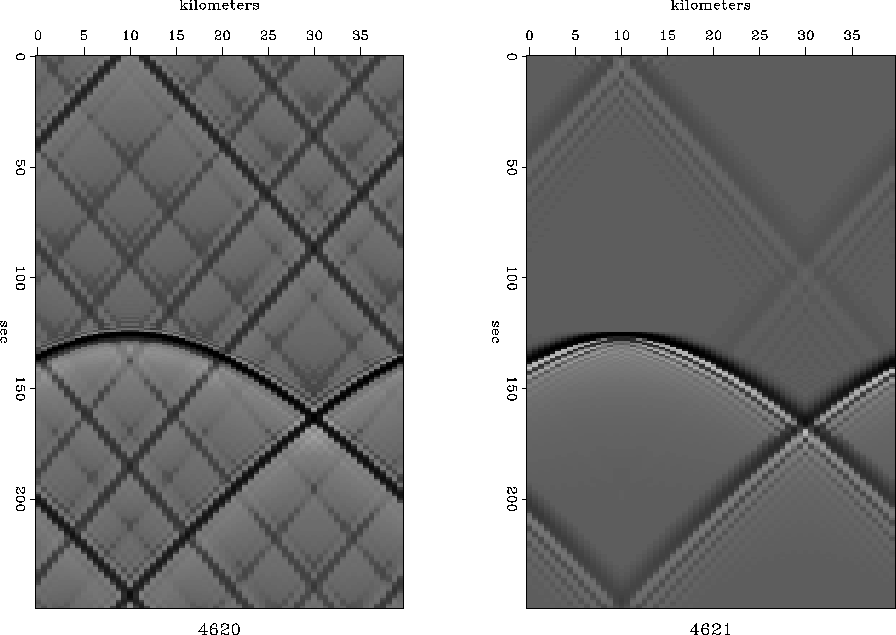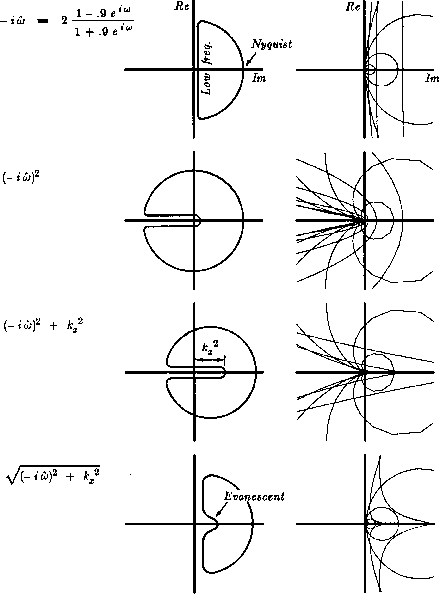




Next: Fractional integration and constant
Up: IMPEDANCE
Previous: Functional analysis
Let  denote the causal, positive, discrete
representation of the differentiation operator, say,
denote the causal, positive, discrete
representation of the differentiation operator, say,
|  |
(61) |
Figure 6
compares hyperbolas constructed with  to those
constructed with
to those
constructed with  .
.
cxfreq
Figure 6
Hyperbolas with real frequency (left) and complex frequency (right).
(Plotting uses square root gain described in chapter
![[*]](http://sepwww.stanford.edu/latex2html/cross_ref_motif.gif) ).
).





You see a pleasing drop in wraparound noise.
It seems to work better than the  in chapter
in chapter ![[*]](http://sepwww.stanford.edu/latex2html/cross_ref_motif.gif) .
As we will see, the introduction of complex-valued
.
As we will see, the introduction of complex-valued  leads
to a more natural handling of the square root at the evanescent transition.
leads
to a more natural handling of the square root at the evanescent transition.
Consider the following recursion starting from R0 = s:
|  |
(62) |
This recursion produces continued fractions.
Francis Muir introduced it
as a means of developing wide-angle square-root approximations
for migration (chapter ![[*]](http://sepwww.stanford.edu/latex2html/cross_ref_motif.gif) ).
and he developed his three rules to show
that every Rn is an impedance function.
To see why every Rn is an impedance function, first note
that the denominator s + Rn is, for n=0, the sum of two
impedance functions.
Then its inverse is an impedance function,
and multiplication by the real positive
constant X2 and addition of another s both preserve
the properties of impedance functions.
Recursively we see that all the Rn are impedances.
).
and he developed his three rules to show
that every Rn is an impedance function.
To see why every Rn is an impedance function, first note
that the denominator s + Rn is, for n=0, the sum of two
impedance functions.
Then its inverse is an impedance function,
and multiplication by the real positive
constant X2 and addition of another s both preserve
the properties of impedance functions.
Recursively we see that all the Rn are impedances.
As N becomes large this recursion
either converges or it does not.
Supposing that it does, we can see what it will converge to
by setting  .Thus,
.Thus,
|  |
(63) |
| (64) |
| (65) |
| (66) |
In wave-extrapolation
problems X2 is  , where v is
the wave velocity and kx is the horizontal spatial frequency,
namely, the Fourier dual to the horizontal x-axis.
Performing these substitutions we have
, where v is
the wave velocity and kx is the horizontal spatial frequency,
namely, the Fourier dual to the horizontal x-axis.
Performing these substitutions we have
|  |
(67) |
So R is like  .Remember that R0, the first approximation to R, is
.Remember that R0, the first approximation to R, is  .So downgoing waves are
.So downgoing waves are
|  |
(68) |
To switch from downgoing to upcoming waves,
we could either change the sign in front of R or
we take the complex conjugate of R.
The difference is what you want to do with the real part--do you want
the wave to grow or not?
Consider the dissipation of waves in the exploding reflector model.
They damp as they propagate from the explosion to the surface.
This means that as we migrate them,
they should be exponentially growing.
But we don't really want that.
We really want to assure that they are not growing,
perhaps we even want them decaying as we extrapolate them back.
So for migration we downward continue monochromatic waves with
|  |
(69) |
although the real behavior of a wave
from an exploding reflector wave would be
|  |
(70) |
To examine the phase of the complex quantity R, set v=1 obtaining
|  |
(71) |
First note that  is causal
because of its Z-transform representation.
By squaring the Z-transform we see
that
is causal
because of its Z-transform representation.
By squaring the Z-transform we see
that  is also causal.
In the time domain, kx2 is a delta function at the time origin.
Thus R2 given by (71) is causal.
Figure 7 shows how the phase of (71)
is constructed from its constituents.
To illustrate the behavior of
is also causal.
In the time domain, kx2 is a delta function at the time origin.
Thus R2 given by (71) is causal.
Figure 7 shows how the phase of (71)
is constructed from its constituents.
To illustrate the behavior of  from zero to infinity,
I include both an artist's conception and the function on itself,
overlain at various magnifications.
The function
from zero to infinity,
I include both an artist's conception and the function on itself,
overlain at various magnifications.
The function  is a periodic with
is a periodic with  and
its real and imaginary parts plot to a closed curve.
To show the rate of change of the function, I sampled
and
its real and imaginary parts plot to a closed curve.
To show the rate of change of the function, I sampled  at
2
at
2 intervals.
From great distance the function is a circle.
Close up it looks like a line parallel to the imaginary axis.
intervals.
From great distance the function is a circle.
Close up it looks like a line parallel to the imaginary axis.
R2 is causal and from Figure 7 we can see that it has
a ``branch cut'' property.
That is, the phase of R has the positive real property.
Theorem 5 forces R to be causal and minimum phase.
That, with the phase defined by Figure 7,
proves that R, given by (71),
is an impedance function.
kzplane
Figure 7
Complex plane diagram of
constituents of the extrapolation operator R
given by equation (71).
The center column shows an artist's conception.
The right column shows the function
at several magnifications simultaneously.






Next: Fractional integration and constant
Up: IMPEDANCE
Previous: Functional analysis
Stanford Exploration Project
10/31/1997
![]() denote the causal, positive, discrete
representation of the differentiation operator, say,
denote the causal, positive, discrete
representation of the differentiation operator, say,
![]() to those
constructed with
to those
constructed with ![]() .
.
![[*]](http://sepwww.stanford.edu/latex2html/cross_ref_motif.gif) ).
).
![]() in chapter
in chapter ![[*]](http://sepwww.stanford.edu/latex2html/cross_ref_motif.gif) .
As we will see, the introduction of complex-valued
.
As we will see, the introduction of complex-valued ![]() leads
to a more natural handling of the square root at the evanescent transition.
leads
to a more natural handling of the square root at the evanescent transition.
![[*]](http://sepwww.stanford.edu/latex2html/cross_ref_motif.gif) ).
and he developed his three rules to show
that every Rn is an impedance function.
To see why every Rn is an impedance function, first note
that the denominator s + Rn is, for n=0, the sum of two
impedance functions.
Then its inverse is an impedance function,
and multiplication by the real positive
constant X2 and addition of another s both preserve
the properties of impedance functions.
Recursively we see that all the Rn are impedances.
).
and he developed his three rules to show
that every Rn is an impedance function.
To see why every Rn is an impedance function, first note
that the denominator s + Rn is, for n=0, the sum of two
impedance functions.
Then its inverse is an impedance function,
and multiplication by the real positive
constant X2 and addition of another s both preserve
the properties of impedance functions.
Recursively we see that all the Rn are impedances.
![]() .Thus,
.Thus,

![]() , where v is
the wave velocity and kx is the horizontal spatial frequency,
namely, the Fourier dual to the horizontal x-axis.
Performing these substitutions we have
, where v is
the wave velocity and kx is the horizontal spatial frequency,
namely, the Fourier dual to the horizontal x-axis.
Performing these substitutions we have
![]() is causal
because of its Z-transform representation.
By squaring the Z-transform we see
that
is causal
because of its Z-transform representation.
By squaring the Z-transform we see
that ![]() is also causal.
In the time domain, kx2 is a delta function at the time origin.
Thus R2 given by (71) is causal.
Figure 7 shows how the phase of (71)
is constructed from its constituents.
To illustrate the behavior of
is also causal.
In the time domain, kx2 is a delta function at the time origin.
Thus R2 given by (71) is causal.
Figure 7 shows how the phase of (71)
is constructed from its constituents.
To illustrate the behavior of ![]() from zero to infinity,
I include both an artist's conception and the function on itself,
overlain at various magnifications.
The function
from zero to infinity,
I include both an artist's conception and the function on itself,
overlain at various magnifications.
The function ![]() is a periodic with
is a periodic with ![]() and
its real and imaginary parts plot to a closed curve.
To show the rate of change of the function, I sampled
and
its real and imaginary parts plot to a closed curve.
To show the rate of change of the function, I sampled ![]() at
2
at
2![]() intervals.
From great distance the function is a circle.
Close up it looks like a line parallel to the imaginary axis.
intervals.
From great distance the function is a circle.
Close up it looks like a line parallel to the imaginary axis.
